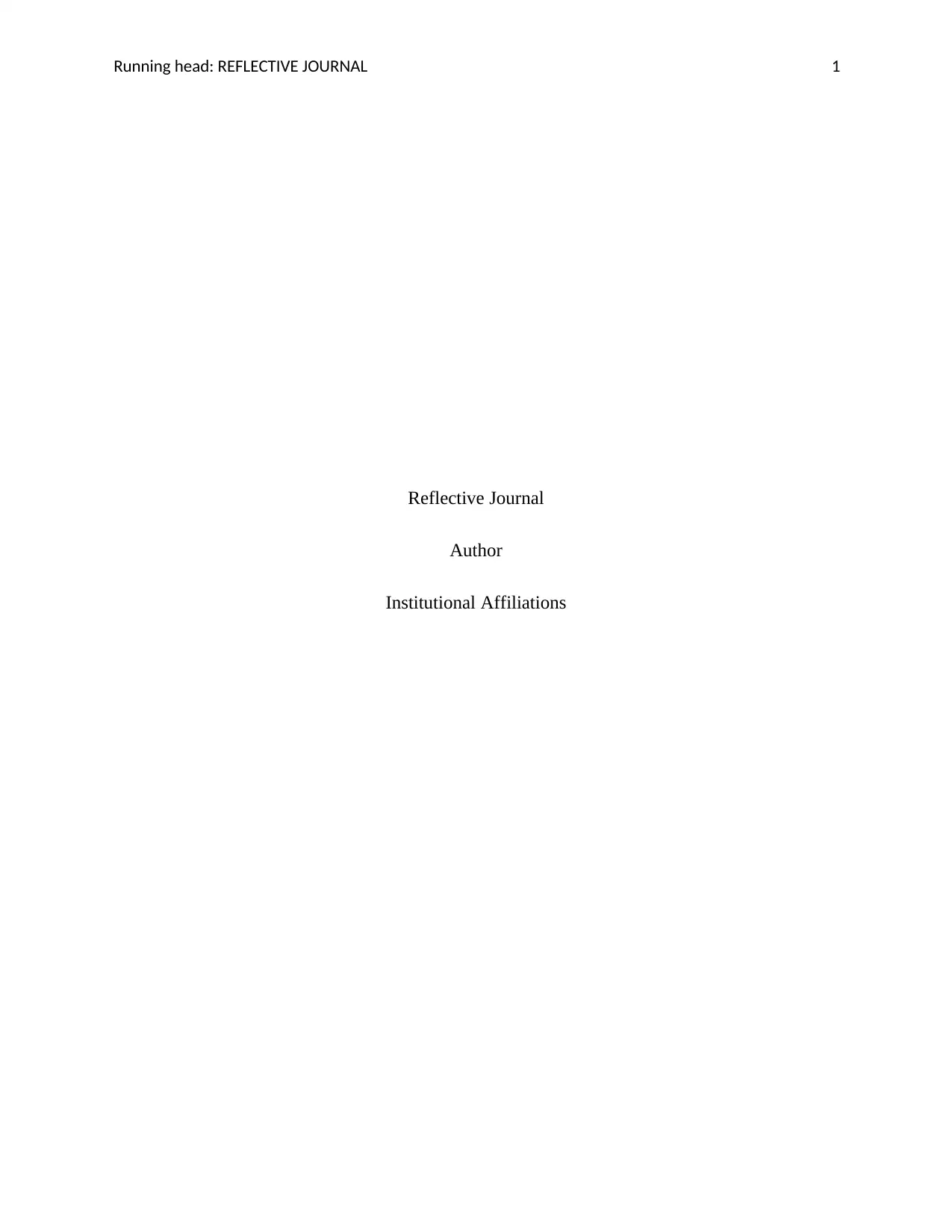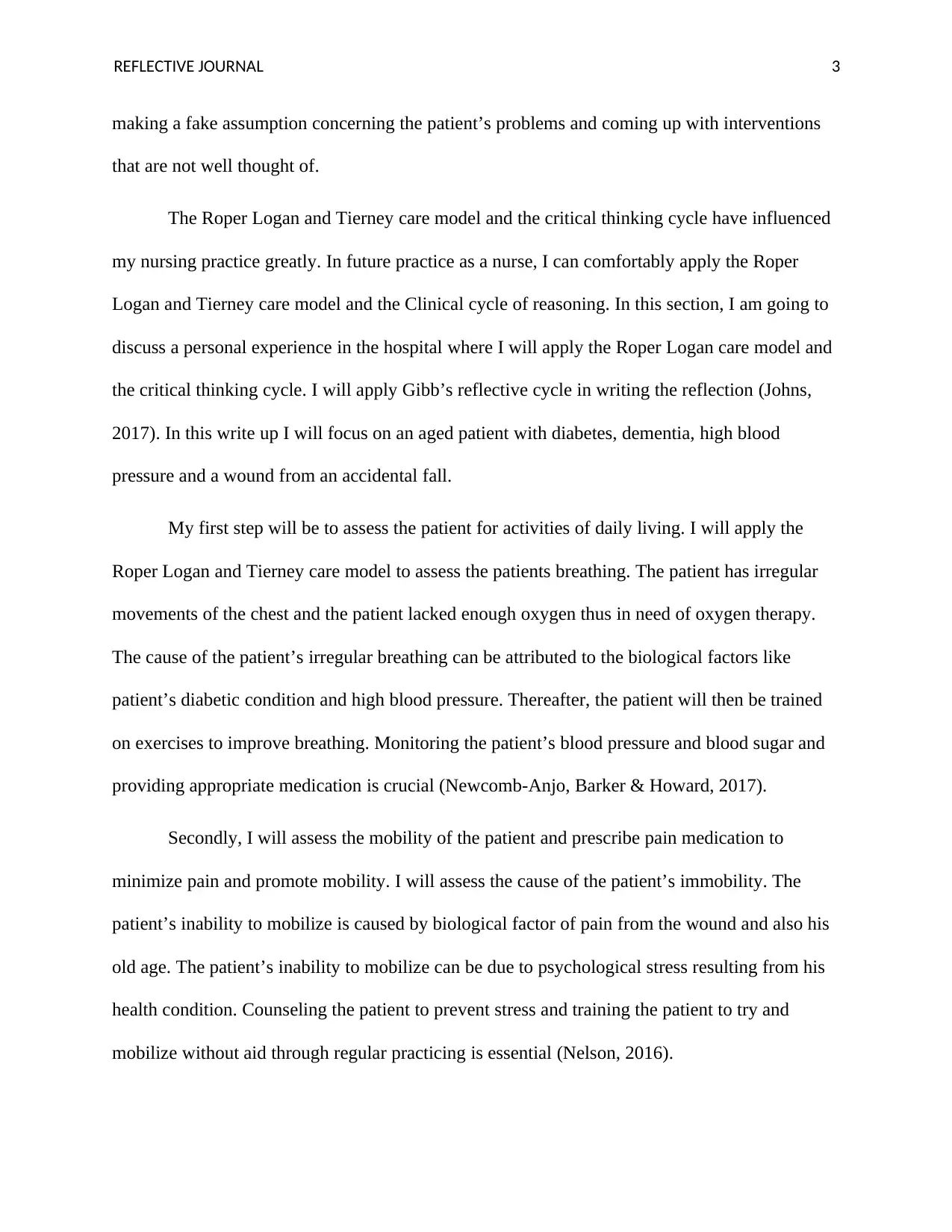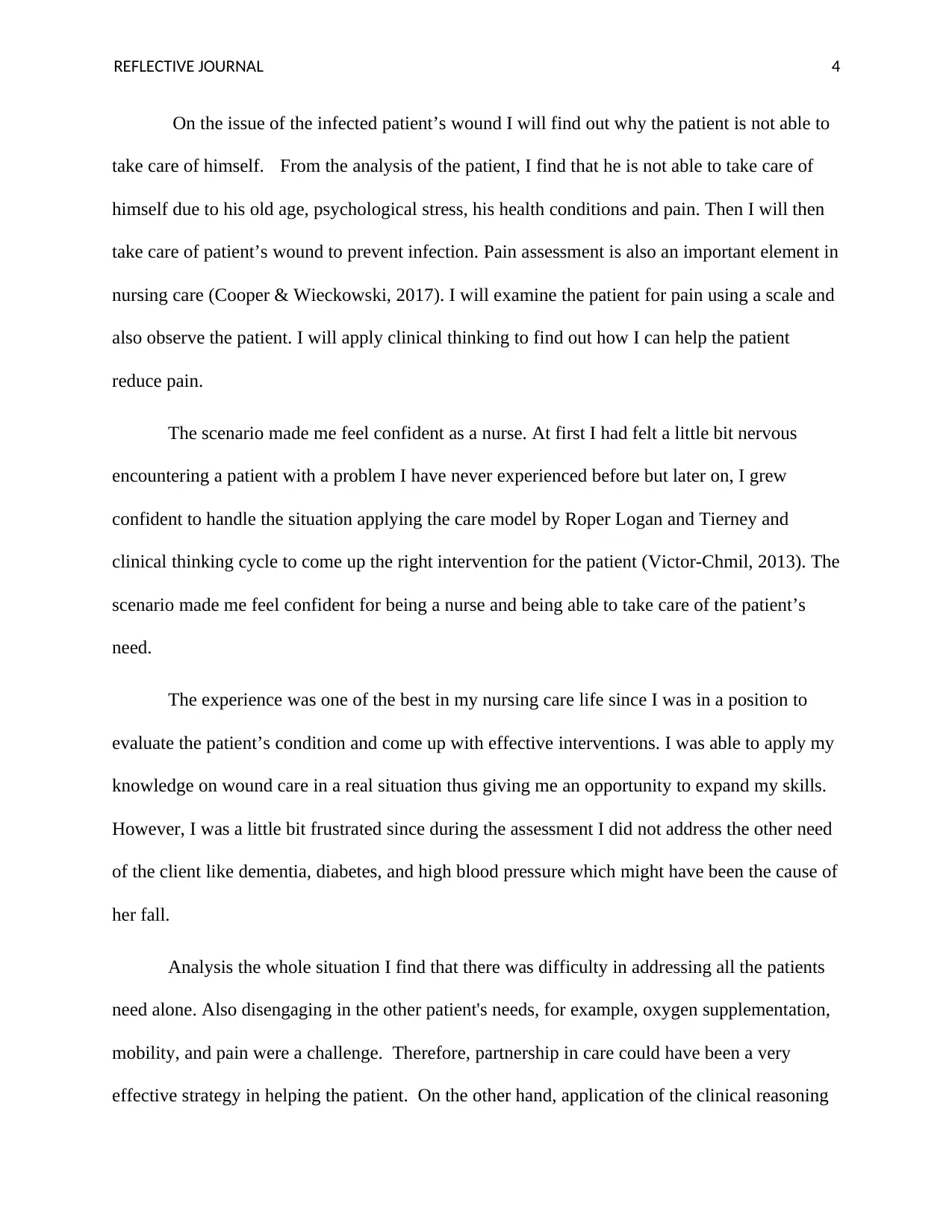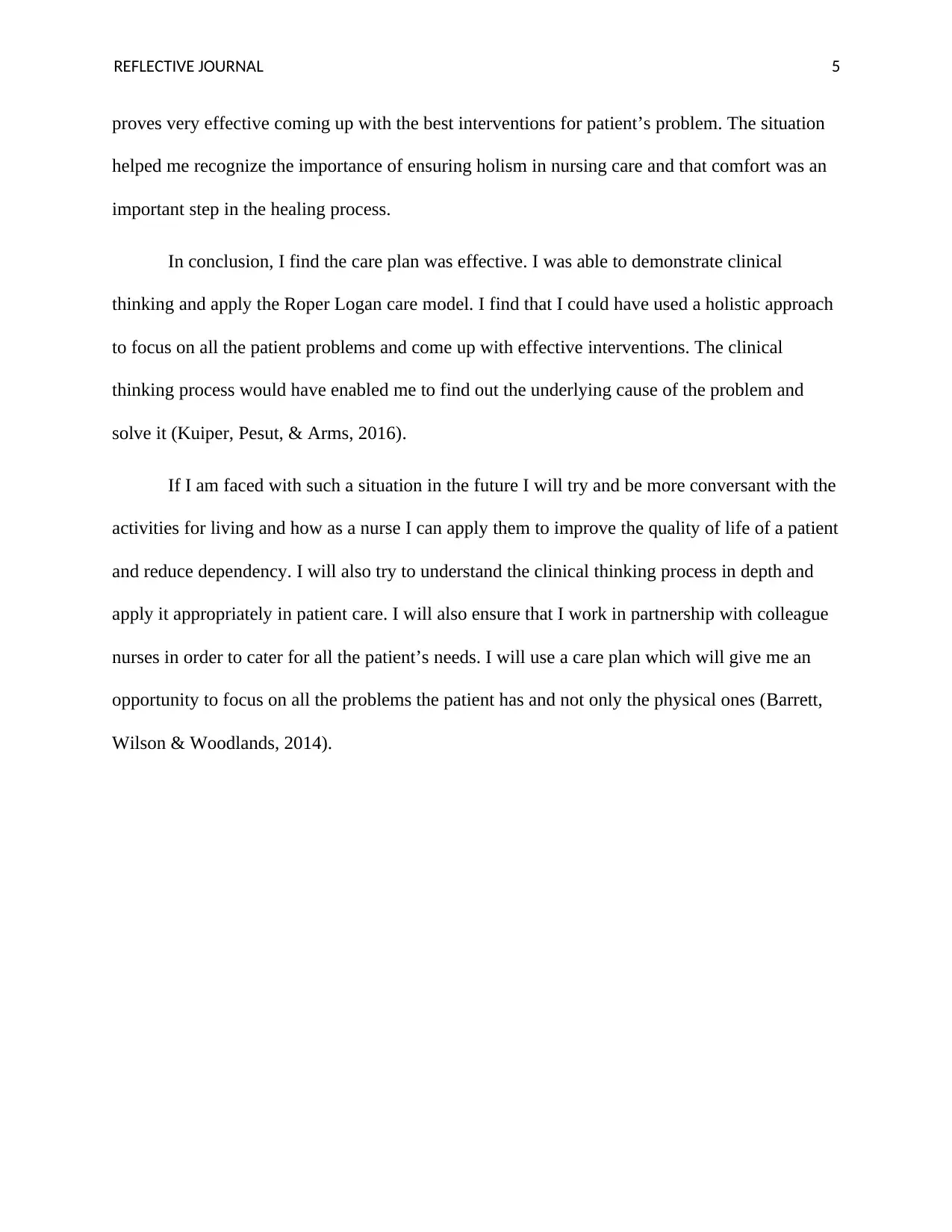Nursing Reflective Journal: Applying Roper Logan and Tierney Model
VerifiedAdded on 2023/06/12
|6
|1706
|231
Journal and Reflective Writing
AI Summary
This reflective journal delves into the application of the Roper Logan and Tierney model of care and clinical reasoning in nursing practice. The author reflects on personal experiences in a hospital setting, focusing on an aged patient with multiple health issues, including diabetes, dementia, and a wound from a fall. The journal highlights the importance of assessing activities of daily living, such as breathing and mobility, and applying the Roper Logan and Tierney model to improve patient outcomes. The reflection also covers the critical thinking cycle and its influence on nursing practice, emphasizing the need for holistic care and partnership with other healthcare professionals. The author discusses feeling confident in applying learned knowledge but acknowledges the challenges of addressing all patient needs comprehensively, suggesting a more collaborative and planned approach for future scenarios. This assignment is available on Desklib, where students can find a wealth of resources, including solved assignments and past papers.

Running head: REFLECTIVE JOURNAL 1
Reflective Journal
Author
Institutional Affiliations
Reflective Journal
Author
Institutional Affiliations
Paraphrase This Document
Need a fresh take? Get an instant paraphrase of this document with our AI Paraphraser

REFLECTIVE JOURNAL 2
After reading the Roper Logan and Tierney model of care I am now conversant with how
activities of daily living can be applied in nursing care to improve a patient’s quality of life and
reduce dependency. The model is named after the people who developed it inspired by Virginia
Henderson’s work (Williams, 2017). From the theory, I have learned what living means and how
as a nurse I can intervene to support patient’s independence where the patient might find it had to
be dependent. The twelve daily living activities are eating, breathing, drinking, eliminating, body
temperature control, personal cleansing, sleeping, playing and working, mobilizing and dying
(Williams, 2017). All these activities are applied as a guide in planning, assessing, implementing
and evaluating a patient in care provision. Using the model, I can assess the dependence of the
patient and his or her potential for independence in daily living activities. Also, I can assess the
psychological, social and biological factors causing the problems in the patient’s activities of
daily living. Thereafter, I can determine which intervention when applied will lead to an increase
in the patient’s dependence and also any kind of support needed to end any form of existing
dependency.
On the other hand, the clinical reasoning process was a great read. I learned that as a
nurse, it is important to have clinical reasoning skills in order to improve patient outcomes
(Ashley & Stamp, 2014). Nursing training should start at the undergraduate level in order to
enable students to develop clinical thinking and critical thinking skills. The clinical thinking
process has eight main phases which include looking, collecting, processing, deciding, planning,
acting, evaluating and finally reflecting. Despite the fact that each phase stands as a distinct
element, they all merge and the distinction between them becomes blurred. As a nurse, one
should combine the different phases or move back and forth between the steps before deciding
on the right intervention. A clear understanding of each phase is crucial for nurses to avoid
After reading the Roper Logan and Tierney model of care I am now conversant with how
activities of daily living can be applied in nursing care to improve a patient’s quality of life and
reduce dependency. The model is named after the people who developed it inspired by Virginia
Henderson’s work (Williams, 2017). From the theory, I have learned what living means and how
as a nurse I can intervene to support patient’s independence where the patient might find it had to
be dependent. The twelve daily living activities are eating, breathing, drinking, eliminating, body
temperature control, personal cleansing, sleeping, playing and working, mobilizing and dying
(Williams, 2017). All these activities are applied as a guide in planning, assessing, implementing
and evaluating a patient in care provision. Using the model, I can assess the dependence of the
patient and his or her potential for independence in daily living activities. Also, I can assess the
psychological, social and biological factors causing the problems in the patient’s activities of
daily living. Thereafter, I can determine which intervention when applied will lead to an increase
in the patient’s dependence and also any kind of support needed to end any form of existing
dependency.
On the other hand, the clinical reasoning process was a great read. I learned that as a
nurse, it is important to have clinical reasoning skills in order to improve patient outcomes
(Ashley & Stamp, 2014). Nursing training should start at the undergraduate level in order to
enable students to develop clinical thinking and critical thinking skills. The clinical thinking
process has eight main phases which include looking, collecting, processing, deciding, planning,
acting, evaluating and finally reflecting. Despite the fact that each phase stands as a distinct
element, they all merge and the distinction between them becomes blurred. As a nurse, one
should combine the different phases or move back and forth between the steps before deciding
on the right intervention. A clear understanding of each phase is crucial for nurses to avoid

REFLECTIVE JOURNAL 3
making a fake assumption concerning the patient’s problems and coming up with interventions
that are not well thought of.
The Roper Logan and Tierney care model and the critical thinking cycle have influenced
my nursing practice greatly. In future practice as a nurse, I can comfortably apply the Roper
Logan and Tierney care model and the Clinical cycle of reasoning. In this section, I am going to
discuss a personal experience in the hospital where I will apply the Roper Logan care model and
the critical thinking cycle. I will apply Gibb’s reflective cycle in writing the reflection (Johns,
2017). In this write up I will focus on an aged patient with diabetes, dementia, high blood
pressure and a wound from an accidental fall.
My first step will be to assess the patient for activities of daily living. I will apply the
Roper Logan and Tierney care model to assess the patients breathing. The patient has irregular
movements of the chest and the patient lacked enough oxygen thus in need of oxygen therapy.
The cause of the patient’s irregular breathing can be attributed to the biological factors like
patient’s diabetic condition and high blood pressure. Thereafter, the patient will then be trained
on exercises to improve breathing. Monitoring the patient’s blood pressure and blood sugar and
providing appropriate medication is crucial (Newcomb-Anjo, Barker & Howard, 2017).
Secondly, I will assess the mobility of the patient and prescribe pain medication to
minimize pain and promote mobility. I will assess the cause of the patient’s immobility. The
patient’s inability to mobilize is caused by biological factor of pain from the wound and also his
old age. The patient’s inability to mobilize can be due to psychological stress resulting from his
health condition. Counseling the patient to prevent stress and training the patient to try and
mobilize without aid through regular practicing is essential (Nelson, 2016).
making a fake assumption concerning the patient’s problems and coming up with interventions
that are not well thought of.
The Roper Logan and Tierney care model and the critical thinking cycle have influenced
my nursing practice greatly. In future practice as a nurse, I can comfortably apply the Roper
Logan and Tierney care model and the Clinical cycle of reasoning. In this section, I am going to
discuss a personal experience in the hospital where I will apply the Roper Logan care model and
the critical thinking cycle. I will apply Gibb’s reflective cycle in writing the reflection (Johns,
2017). In this write up I will focus on an aged patient with diabetes, dementia, high blood
pressure and a wound from an accidental fall.
My first step will be to assess the patient for activities of daily living. I will apply the
Roper Logan and Tierney care model to assess the patients breathing. The patient has irregular
movements of the chest and the patient lacked enough oxygen thus in need of oxygen therapy.
The cause of the patient’s irregular breathing can be attributed to the biological factors like
patient’s diabetic condition and high blood pressure. Thereafter, the patient will then be trained
on exercises to improve breathing. Monitoring the patient’s blood pressure and blood sugar and
providing appropriate medication is crucial (Newcomb-Anjo, Barker & Howard, 2017).
Secondly, I will assess the mobility of the patient and prescribe pain medication to
minimize pain and promote mobility. I will assess the cause of the patient’s immobility. The
patient’s inability to mobilize is caused by biological factor of pain from the wound and also his
old age. The patient’s inability to mobilize can be due to psychological stress resulting from his
health condition. Counseling the patient to prevent stress and training the patient to try and
mobilize without aid through regular practicing is essential (Nelson, 2016).
⊘ This is a preview!⊘
Do you want full access?
Subscribe today to unlock all pages.

Trusted by 1+ million students worldwide

REFLECTIVE JOURNAL 4
On the issue of the infected patient’s wound I will find out why the patient is not able to
take care of himself. From the analysis of the patient, I find that he is not able to take care of
himself due to his old age, psychological stress, his health conditions and pain. Then I will then
take care of patient’s wound to prevent infection. Pain assessment is also an important element in
nursing care (Cooper & Wieckowski, 2017). I will examine the patient for pain using a scale and
also observe the patient. I will apply clinical thinking to find out how I can help the patient
reduce pain.
The scenario made me feel confident as a nurse. At first I had felt a little bit nervous
encountering a patient with a problem I have never experienced before but later on, I grew
confident to handle the situation applying the care model by Roper Logan and Tierney and
clinical thinking cycle to come up the right intervention for the patient (Victor-Chmil, 2013). The
scenario made me feel confident for being a nurse and being able to take care of the patient’s
need.
The experience was one of the best in my nursing care life since I was in a position to
evaluate the patient’s condition and come up with effective interventions. I was able to apply my
knowledge on wound care in a real situation thus giving me an opportunity to expand my skills.
However, I was a little bit frustrated since during the assessment I did not address the other need
of the client like dementia, diabetes, and high blood pressure which might have been the cause of
her fall.
Analysis the whole situation I find that there was difficulty in addressing all the patients
need alone. Also disengaging in the other patient's needs, for example, oxygen supplementation,
mobility, and pain were a challenge. Therefore, partnership in care could have been a very
effective strategy in helping the patient. On the other hand, application of the clinical reasoning
On the issue of the infected patient’s wound I will find out why the patient is not able to
take care of himself. From the analysis of the patient, I find that he is not able to take care of
himself due to his old age, psychological stress, his health conditions and pain. Then I will then
take care of patient’s wound to prevent infection. Pain assessment is also an important element in
nursing care (Cooper & Wieckowski, 2017). I will examine the patient for pain using a scale and
also observe the patient. I will apply clinical thinking to find out how I can help the patient
reduce pain.
The scenario made me feel confident as a nurse. At first I had felt a little bit nervous
encountering a patient with a problem I have never experienced before but later on, I grew
confident to handle the situation applying the care model by Roper Logan and Tierney and
clinical thinking cycle to come up the right intervention for the patient (Victor-Chmil, 2013). The
scenario made me feel confident for being a nurse and being able to take care of the patient’s
need.
The experience was one of the best in my nursing care life since I was in a position to
evaluate the patient’s condition and come up with effective interventions. I was able to apply my
knowledge on wound care in a real situation thus giving me an opportunity to expand my skills.
However, I was a little bit frustrated since during the assessment I did not address the other need
of the client like dementia, diabetes, and high blood pressure which might have been the cause of
her fall.
Analysis the whole situation I find that there was difficulty in addressing all the patients
need alone. Also disengaging in the other patient's needs, for example, oxygen supplementation,
mobility, and pain were a challenge. Therefore, partnership in care could have been a very
effective strategy in helping the patient. On the other hand, application of the clinical reasoning
Paraphrase This Document
Need a fresh take? Get an instant paraphrase of this document with our AI Paraphraser

REFLECTIVE JOURNAL 5
proves very effective coming up with the best interventions for patient’s problem. The situation
helped me recognize the importance of ensuring holism in nursing care and that comfort was an
important step in the healing process.
In conclusion, I find the care plan was effective. I was able to demonstrate clinical
thinking and apply the Roper Logan care model. I find that I could have used a holistic approach
to focus on all the patient problems and come up with effective interventions. The clinical
thinking process would have enabled me to find out the underlying cause of the problem and
solve it (Kuiper, Pesut, & Arms, 2016).
If I am faced with such a situation in the future I will try and be more conversant with the
activities for living and how as a nurse I can apply them to improve the quality of life of a patient
and reduce dependency. I will also try to understand the clinical thinking process in depth and
apply it appropriately in patient care. I will also ensure that I work in partnership with colleague
nurses in order to cater for all the patient’s needs. I will use a care plan which will give me an
opportunity to focus on all the problems the patient has and not only the physical ones (Barrett,
Wilson & Woodlands, 2014).
proves very effective coming up with the best interventions for patient’s problem. The situation
helped me recognize the importance of ensuring holism in nursing care and that comfort was an
important step in the healing process.
In conclusion, I find the care plan was effective. I was able to demonstrate clinical
thinking and apply the Roper Logan care model. I find that I could have used a holistic approach
to focus on all the patient problems and come up with effective interventions. The clinical
thinking process would have enabled me to find out the underlying cause of the problem and
solve it (Kuiper, Pesut, & Arms, 2016).
If I am faced with such a situation in the future I will try and be more conversant with the
activities for living and how as a nurse I can apply them to improve the quality of life of a patient
and reduce dependency. I will also try to understand the clinical thinking process in depth and
apply it appropriately in patient care. I will also ensure that I work in partnership with colleague
nurses in order to cater for all the patient’s needs. I will use a care plan which will give me an
opportunity to focus on all the problems the patient has and not only the physical ones (Barrett,
Wilson & Woodlands, 2014).

REFLECTIVE JOURNAL 6
References
Ashley, J., & Stamp, K. (2014). Learning to think like a nurse: The development of clinical
judgment in nursing students. Journal of Nursing Education, 53(9), 519-525.
Barrett, D., Wilson, B., & Woodlands, A. (2014). Care Planning: A guide for nurses. Routledge.
Cooper, L. D., & Wieckowski, A. T. (2017). A structured approach to reflective practice training
in a clinical practicum. Training and Education in Professional Psychology, 11(4), 252.
Johns, C. (2017). Becoming a reflective practitioner. John Wiley & Sons.
Kuiper, R., Pesut, D. J., & Arms, T. E. (2016). Clinical reasoning and care coordination in
advanced practice nursing. Springer Publishing Company.
Nelson, S. (2016). The role of the nurse in assessing mobility decline in older people with
intellectual disabilities. Learning Disability Practice (2014+), 19(9), 19.
Newcomb-Anjo, S. E., Barker, E. T., & Howard, A. L. (2017). A person-centered analysis of risk
factors that compromise wellbeing in emerging adulthood. Journal of youth and
adolescence, 46(4), 867-883. DOI 10.1007/s10964-016-0603-2.
Victor-Chmil, J. (2013). Critical thinking versus clinical reasoning versus clinical judgment:
Differential diagnosis. Nurse Educator, 38(1), 34-36.
Williams, B. C. (2017). The Roper-Logan-Tierney model of nursing. Nursing2017 Critical
Care, 12(1), 17-20.
References
Ashley, J., & Stamp, K. (2014). Learning to think like a nurse: The development of clinical
judgment in nursing students. Journal of Nursing Education, 53(9), 519-525.
Barrett, D., Wilson, B., & Woodlands, A. (2014). Care Planning: A guide for nurses. Routledge.
Cooper, L. D., & Wieckowski, A. T. (2017). A structured approach to reflective practice training
in a clinical practicum. Training and Education in Professional Psychology, 11(4), 252.
Johns, C. (2017). Becoming a reflective practitioner. John Wiley & Sons.
Kuiper, R., Pesut, D. J., & Arms, T. E. (2016). Clinical reasoning and care coordination in
advanced practice nursing. Springer Publishing Company.
Nelson, S. (2016). The role of the nurse in assessing mobility decline in older people with
intellectual disabilities. Learning Disability Practice (2014+), 19(9), 19.
Newcomb-Anjo, S. E., Barker, E. T., & Howard, A. L. (2017). A person-centered analysis of risk
factors that compromise wellbeing in emerging adulthood. Journal of youth and
adolescence, 46(4), 867-883. DOI 10.1007/s10964-016-0603-2.
Victor-Chmil, J. (2013). Critical thinking versus clinical reasoning versus clinical judgment:
Differential diagnosis. Nurse Educator, 38(1), 34-36.
Williams, B. C. (2017). The Roper-Logan-Tierney model of nursing. Nursing2017 Critical
Care, 12(1), 17-20.
⊘ This is a preview!⊘
Do you want full access?
Subscribe today to unlock all pages.

Trusted by 1+ million students worldwide
1 out of 6
Related Documents
Your All-in-One AI-Powered Toolkit for Academic Success.
+13062052269
info@desklib.com
Available 24*7 on WhatsApp / Email
![[object Object]](/_next/static/media/star-bottom.7253800d.svg)
Unlock your academic potential
Copyright © 2020–2025 A2Z Services. All Rights Reserved. Developed and managed by ZUCOL.



